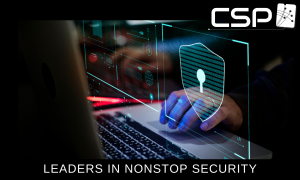CSP Addresses Zero-Trust and Security Vulnerabilities with New Solutions

In case you missed it, news came out mid-summer of how “Princeton (University) Grades Password Policies of Most Popular Websites.” In their peer-reviewed paper, the researchers wrote: “According to industry estimates, close to 50% of data breaches involved authentication failures. As such, the need to use strong passwords remains unchanged. For the study, the researchers reverse-engineered the password policies of these websites to determine if they were following what the researchers call “long-established best practices for helping users create stronger passwords.” Of the 120 websites reviewed, the researchers concluded only 15 were following best practices.
Such dismal performance should be sounding alarm bells for all of us. The NonStop community isn’t immune to supporting weak passwords. However, in this day and age, one would have anticipated a more thorough approach to securing access to anything related to the customer-facing transaction processing applications found on NonStop systems. From our observations, a lot more can be achieved by simply applying a zero-trust model when it comes to authentication. But what do we mean by zero-trust, and what should we do to better abide by a zero-trust model?
Zero-trust means authenticating anyone who accesses your networks to ensure they are authorized to access specific domains. A typical zero-trust model for NonStop systems might include validating identity, aligning appropriate access management, and implementing technologies such as multi-factor authentication. To this end, CSP provides CSP Authenticator+®.
With CSP Authenticator+, NonStop users will have support for numerous authentication factors that make it easier to implement a zero-trust model. The new CSP Authenticator+ cloud-native application was developed using a modern cloud-based framework. This redesign focuses on providing security, flexibility, and scalability. It will prove beneficial for ensuring multi-factor authentication, given that the new cloud-native application supports high availability, Kubernetes deployments, and additional features.
CSP also provides CSP Vulnerability Scanner™. The tool analyzes risks and identifies vulnerabilities by checking the NonStop system configuration, access permissions, and security settings. It generates insightful reports for users and recommends changes to improve the security posture. What makes it an effective tool is its simplicity and ease of deployment. The installation process is quick, and the solution is easy to use. This solution is a perfect pairing to CSP Authenticator+ whenever delivering true zero-trust is implemented.
As reported in a press release from October 13, 2022, Gartner Inc. “Identifies Three Factors Influencing Growth in Security Spending.” These three factors are an increase in remote and hybrid work, the transition from virtual private networks (VPNs) to zero-trust network access (ZTNA), and the shift to cloud-based delivery models. Not surprising to anyone, including NonStop users, was the following observation by Ruggero Contu, senior director analyst at Gartner: “The pandemic accelerated hybrid work and the shift to the cloud, challenging the Chief Information Security Officer (CISO) to secure an increasingly distributed enterprise.”
This year’s NonStop Technical Boot Camp will be over as you read this CSP update, and we do plan to discuss both products at TBC22. Even as we look forward to participating in the event and supporting it as a Platinum Sponsor, we are certain that security topics such as zero-trust implementations and determining real-world vulnerabilities will be much-discussed. Expect to hear more about all that happened at TBC22 in later articles and commentaries.
CSP – Compliance at your Fingertips ®
For complimentary access to CSP-Wiki®, an extensive repository of NonStop security knowledge and best practices, please visit wiki.cspsecurity.com
We Built the Wiki for NonStop Security ®
+1(905) 568 –8900












